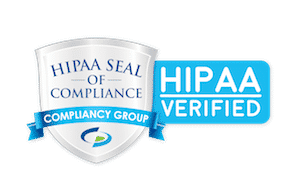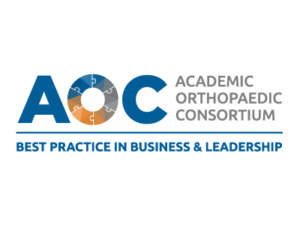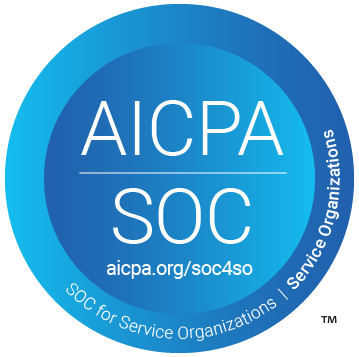Healthcare leaders often operate under a simple assumption: more patients equals more revenue, which should translate to more profit. It’s a logical marketing strategy that drives countless campaigns, expansion efforts, and strategic initiatives across the industry. Yet, many healthcare organizations face a puzzling situation where patient volume continues to grow while profits remain flat or even decline.
This phenomenon, commonly referred to as the growth paradox, reveals a fundamental misunderstanding about the relationship between patient acquisition and financial success in healthcare. The reality is more complex than the simple idea that more patient appointments mean more profit. Organizations that ignore this complexity may find themselves stuck in costly growth cycles, which don’t always deliver sustainable returns.
The Hidden Costs of Patient Acquisition
 When healthcare organizations focus primarily on bringing in new patients, they often overlook the substantial costs associated with acquisition. Marketing expenses, referral incentives, and promotional campaigns can quickly add up. This creates a significant investment that must be recouped through patient revenue. However, the break-even point for new patient acquisition is typically much longer than many organizations realize.
When healthcare organizations focus primarily on bringing in new patients, they often overlook the substantial costs associated with acquisition. Marketing expenses, referral incentives, and promotional campaigns can quickly add up. This creates a significant investment that must be recouped through patient revenue. However, the break-even point for new patient acquisition is typically much longer than many organizations realize.
Consider the full patient journey from initial awareness to the first appointment. Digital marketing campaigns, search engine optimization, content creation, and social media management all require ongoing investment. Traditional marketing channels like print advertising, radio spots, and community outreach events carry their own costs. When you factor in the time required to manage these initiatives, the true cost of acquiring each new patient often surprises healthcare marketers.
More surprising is often the reality that not all acquired patients provide equal value. A patient who schedules a single consultation and never returns creates a net loss when you consider acquisition costs. Even patients who visit regularly may not bring in enough revenue to cover the initial investment required to attract them. This is particularly true in competitive markets where acquisition costs continue to rise as organizations compete for the same patients.
The timing of revenue realization also creates cash flow challenges. Organizations often pay marketing expenses upfront while patient revenue trickles in over months or years. This creates a gap between investment and return that can strain financial resources, especially for smaller practices or organizations with limited marketing funds.
The True Value of Patient Retention
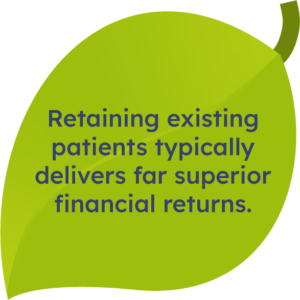 While acquiring new patients captures attention and feels like growth, retaining existing patients typically delivers far superior financial returns. Existing patients already trust your organization, understand your processes, and have overcome the initial barriers to seeking care. They’re more likely to follow through with treatment recommendations, schedule follow-up appointments, and refer friends and family members.
While acquiring new patients captures attention and feels like growth, retaining existing patients typically delivers far superior financial returns. Existing patients already trust your organization, understand your processes, and have overcome the initial barriers to seeking care. They’re more likely to follow through with treatment recommendations, schedule follow-up appointments, and refer friends and family members.
The economics of retention are compelling. Existing patients don’t require the same marketing investment that new patient acquisition demands. They already know your services. They have good relationships with your staff. They are more likely to accept treatment advice. This translates to higher conversion rates, better appointment attendance, and even increased treatment compliance.
Long-term patients also tend to utilize a broader range of services over time. A patient who initially visits for a specific concern may eventually need additional treatments, preventive care, surgery, or management of chronic conditions. This organic expansion of services represents high-margin revenue because it requires minimal additional marketing investment.
Perhaps most importantly, satisfied long-term patients become your most effective marketing asset. Online referrals from trusted patients often carry more weight than any paid advertising campaign. These referrals tend to be higher-quality leads because they come with trust and clear expectations about your services.
The Quality Versus Quantity Equation
The growth paradox becomes even more apparent when organizations prioritize patient volume over patient quality. High patient turnover might create the appearance of a thriving practice, but it often indicates underlying problems with patient satisfaction, treatment outcomes, or service delivery. Organizations caught in this cycle keep replacing previous patients with new ones, creating an expensive treadmill of patient acquisition efforts.
Quality patients, on the other hand, represent sustainable growth. These are individuals who value your services, comply with treatment recommendations, and maintain ongoing relationships with your organization. They’re more likely to invest in comprehensive care rather than seeking the cheapest options available. They also tend to be more understanding when issues arise and more willing to provide constructive feedback that helps improve your services.
The shift from quantity to quality requires a fundamental change in how success is measured. Instead of focusing solely on new patient numbers, organizations need to track metrics like patient lifetime value, retention rates, treatment completion rates, and referral generation. These indicators provide a more accurate picture of financial health and sustainable growth potential.
This quality-focused approach also improves operational efficiency. When you’re not constantly onboarding new patients, your staff can focus on delivering exceptional care to existing ones. This leads to better patient outcomes, higher satisfaction scores, and more positive reviews—all of which support organic growth without the high costs of traditional acquisition methods.
Operational Strain and Resource Allocation
 Rapid patient growth can actually harm profitability by straining operational resources beyond their capacity. When organizations focus intensively on business growth by bringing in new patients without proportionally investing in infrastructure, staff, and systems, the quality of care inevitably suffers. This creates a vicious cycle where new patients have poor experiences, leading to higher churn rates and the need for even more aggressive acquisition efforts.
Rapid patient growth can actually harm profitability by straining operational resources beyond their capacity. When organizations focus intensively on business growth by bringing in new patients without proportionally investing in infrastructure, staff, and systems, the quality of care inevitably suffers. This creates a vicious cycle where new patients have poor experiences, leading to higher churn rates and the need for even more aggressive acquisition efforts.
The hidden costs of operational strain are significant. Overbooked schedules lead to longer wait times, rushed appointments, and frustrated patients. Overwhelmed staff members are more likely to make errors, provide subpar service, or leave for less stressful positions. The cost of staff turnover alone can quickly erode the financial benefits of increased patient volume.
Technology systems that work fine for smaller patient loads often become bottlenecks as volume increases. Scheduling systems may crash, electronic health records may slow down, and communication tools may become unreliable. These failures don’t just frustrate patients and staff—they also reduce efficiency and increase the time required to complete basic tasks.
The administrative burden of managing larger patient volumes also increases costs in ways that aren’t immediately obvious. More patients lead to more insurance verifications, more billing complexity, more customer service inquiries, and more compliance requirements. These backend processes are essential but don’t directly generate revenue, creating a drag on profitability as volume increases.
The Sustainability Factor
Perhaps the most critical aspect of the growth paradox is the question of sustainability. Organizations that build their growth strategy primarily on new patient acquisition often find themselves vulnerable to market changes, competitive pressures, and economic downturns. When marketing budgets get cut or acquisition costs rise, these organizations can experience rapid declines in patient volume and revenue.
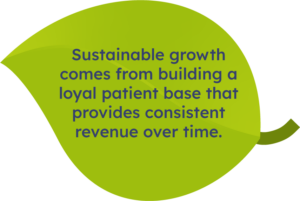 Sustainable growth, in contrast, comes from building a loyal patient base that provides consistent revenue over time. These organizations are more resilient because they’re not dependent on constantly feeding the acquisition pipeline. They can weather market volatility, reduce marketing expenses during tough times, and maintain steady cash flow even when new patient volume temporarily declines.
Sustainable growth, in contrast, comes from building a loyal patient base that provides consistent revenue over time. These organizations are more resilient because they’re not dependent on constantly feeding the acquisition pipeline. They can weather market volatility, reduce marketing expenses during tough times, and maintain steady cash flow even when new patient volume temporarily declines.
The investment in patient relationships also pays dividends during challenging periods. Loyal patients are more likely to continue their care even when financial circumstances become difficult. They’re more willing to work with payment plans, accept generic medications, or delay non-essential treatments rather than switching to competitors. This loyalty provides a buffer against economic uncertainty that acquisition-focused strategies simply cannot match.
Building sustainable growth requires patience and long-term thinking. It means sometimes saying no to short-term opportunities that might boost immediate revenue but don’t align with long-term patient value. It means investing in patient experience improvements that may not show immediate returns but build lasting loyalty over time.
Rethinking Growth Strategy
The solution to the growth paradox isn’t to stop acquiring new patients. Instead, healthcare organizations should aim for strategic growth and market expansion. Successful healthcare organizations understand that sustainable profitability comes from balancing acquisition with retention, focusing on patient lifetime value rather than transaction volume, and building operational capacity that can deliver consistent quality regardless of patient load.
This balanced approach requires different metrics and different mindsets. Organizations should focus on patient retention rates instead of only celebrating new patient numbers. They should also track average patient lifetime value and net promoter scores. Marketing investments should be evaluated not only for their immediate costs, but also consider the long-term value of the patients they attract.
 The most successful healthcare organizations understand that their primary product isn’t individual appointments or procedures—it’s ongoing relationships with patients who trust them to provide excellent care over time. This patient-centric approach naturally leads to more sustainable growth patterns and better financial outcomes.
The most successful healthcare organizations understand that their primary product isn’t individual appointments or procedures—it’s ongoing relationships with patients who trust them to provide excellent care over time. This patient-centric approach naturally leads to more sustainable growth patterns and better financial outcomes.
When healthcare organizations shift their focus from simply growing patient volume to building patient value, they often discover that profit growth follows naturally. They improve accessibility, quality patients stay longer, spend more, refer others, and require less marketing investment to maintain. They create a virtuous cycle where excellent care leads to patient loyalty, which leads to sustainable revenue growth, and enables continued investment in care quality.
The growth paradox teaches us that in healthcare, as in many service industries, the path to sustainable profitability runs through patient satisfaction and retention rather than pure volume expansion. Organizations that embrace this principle position themselves for long-term success in an increasingly competitive and complex healthcare landscape.



